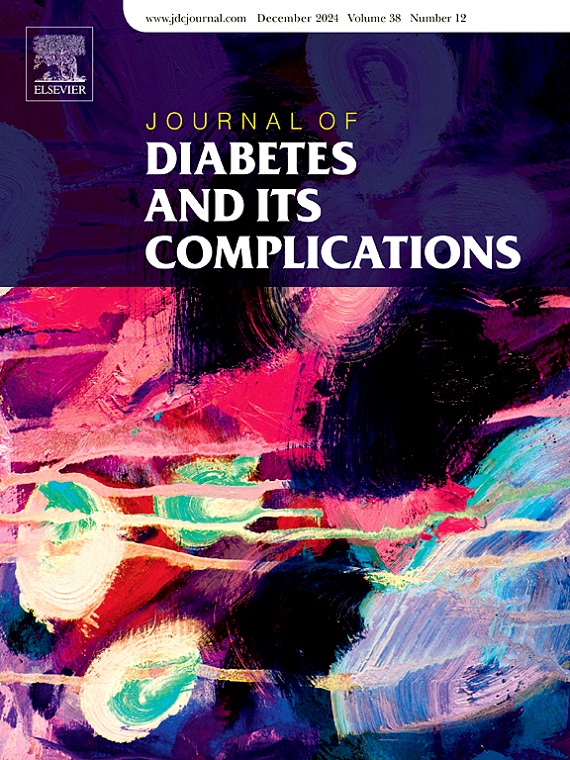Evaluation of IDx-DR software for diabetic retinopathy screening in outpatient clinics: Efficacy, safety, and feasibility in a real-world setting
IF 3.1
3区 医学
Q3 ENDOCRINOLOGY & METABOLISM
引用次数: 0
Abstract
Aims
This study assessed the IDx-DR software's effectiveness as a diabetic retinopathy (DR) screening tool in a routine outpatient setting. It also evaluated the software's safety and feasibility.
Methods
RA prospectively planned analysis of patients with diabetes was conducted at the diabetes outpatient clinic of a specialized tertiary care center from March 2021 to October 2022. These patients underwent retinal imaging with IDx-DR during routine visits.
Results
The majority of the 996 included patients were female (53.1 %), and the median age was 61.1 years. Notably, 40.2 % had a BMI ≥ 30 kg/m2, and 35.8 % were active smokers. DR was detected by IDx-DR in n = 178 (26 %) of patients. 73.1 % of those patients were newly diagnosed with retinopathy without any history of retinopathy in the medical history (p < 0.001). DR patients were older (median 60.4 vs 57.5 years; p = 0.050), had higher HbA1c levels (7.0 % vs. 7.6 %; p < 0.001) and a higher frequency of ophthalmologic check-ups (p = 0.015). In multiple binary logistic regression, use of insulin (OR = 1.735 [1.096; 2.748], p = 0.19) and diabetes duration (medium vs. short: OR = 2.356 [1.36; 4.07], p = 0.002, long vs. short: OR = 1.776 [1.03; 3.06], p = 0.39) independently predicted DR, while age and sex were not significant predictors.
Conclusions
This study supports integrating AI tools like IDx-DR in DR screening. It highlights IDx-DR's utility and efficacy in improving DR detection and patient care, suggesting its potential for broader, cost-effective screening in Austria and possibly elsewhere.
IDx-DR软件用于门诊糖尿病视网膜病变筛查的评估:在现实世界环境中的有效性、安全性和可行性
目的:本研究评估IDx-DR软件作为常规门诊糖尿病视网膜病变(DR)筛查工具的有效性。并对软件的安全性和可行性进行了评估。方法对2021年3月至2022年10月在某专科三级保健中心糖尿病门诊就诊的糖尿病患者进行前瞻性计划分析。这些患者在常规就诊期间接受了IDx-DR视网膜成像。结果996例患者以女性为主(53.1%),中位年龄为61.1岁。值得注意的是,40.2%的人BMI≥30 kg/m2, 35.8%的人是活跃吸烟者。在178例(26%)患者中,IDx-DR检测到DR。73.1%的患者新诊断为视网膜病变,病史中无视网膜病变史(p <;0.001)。DR患者年龄较大(中位60.4 vs 57.5岁;p = 0.050), HbA1c水平较高(7.0% vs 7.6%;p & lt;0.001)和更高的眼科检查频率(p = 0.015)。在多元二元logistic回归中,胰岛素的使用(OR = 1.735 [1.096;2.748], p = 0.19)和糖尿病病程(中vs短:OR = 2.356 [1.36;4.07], p = 0.002,长与短:或= 1.776 (1.03;3.06], p = 0.39)独立预测DR,而年龄和性别无显著预测意义。结论本研究支持将IDx-DR等人工智能工具整合到DR筛查中。它强调了IDx-DR在改善DR检测和患者护理方面的效用和功效,表明它有可能在奥地利和其他地方进行更广泛的、具有成本效益的筛查。
本文章由计算机程序翻译,如有差异,请以英文原文为准。
求助全文
约1分钟内获得全文
求助全文
来源期刊

Journal of diabetes and its complications
医学-内分泌学与代谢
CiteScore
5.90
自引率
3.30%
发文量
153
审稿时长
16 days
期刊介绍:
Journal of Diabetes and Its Complications (JDC) is a journal for health care practitioners and researchers, that publishes original research about the pathogenesis, diagnosis and management of diabetes mellitus and its complications. JDC also publishes articles on physiological and molecular aspects of glucose homeostasis.
The primary purpose of JDC is to act as a source of information usable by diabetes practitioners and researchers to increase their knowledge about mechanisms of diabetes and complications development, and promote better management of people with diabetes who are at risk for those complications.
Manuscripts submitted to JDC can report any aspect of basic, translational or clinical research as well as epidemiology. Topics can range broadly from early prediabetes to late-stage complicated diabetes. Topics relevant to basic/translational reports include pancreatic islet dysfunction and insulin resistance, altered adipose tissue function in diabetes, altered neuronal control of glucose homeostasis and mechanisms of drug action. Topics relevant to diabetic complications include diabetic retinopathy, neuropathy and nephropathy; peripheral vascular disease and coronary heart disease; gastrointestinal disorders, renal failure and impotence; and hypertension and hyperlipidemia.
 求助内容:
求助内容: 应助结果提醒方式:
应助结果提醒方式:


